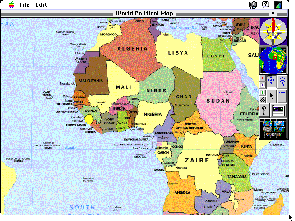
Figure 1-2: The White House Web site
MBONE: Multicasting Tomorrow's Internet
As an extended example of multimedia, consider the Jurassic Park and Back to the Future rides at Disney World. Here, computer technology takes multimedia two steps further. First, it hides the computer from view, and second, it incorporates the sense of touch. You feel these rides as much as you hear or see them. To a lesser degree, three-dimensional games such as Doom accomplish the same goal, although the "touch" in this case tends to be nausea.
The Internet has been home to multimedia -- graphics, animation, and sound files -- for years and years. But because graphics, animation, and sound files are so large, often several megabytes in size, they take a great deal of time (not to mention disk space) to download. For this reason, their availability has been sharply limited for regular users. Let's face it, hearing Bill Clinton's voice welcome you to the White House Web site is mighty cute, but it's hardly worth the four-minute download time with a 14.4 Kbps modem. One possible vision of hell is being forced to listen to the Watergate hearings in their entirety through the World Wide Web and a 14.4 Kbps modem. Or the Lincoln-Douglas debates. Or, God help us, the O. J. trial.

Figure 1-2: The White House Web site
To us, true multimedia means, in part, being able to do all those things that you can already do, but without the interminable waiting. Multimedia is supposed to be an interactive endeavor, but for now Internet multimedia isn't interactive; it's click-and-wait. True multimedia will deliver information fast enough that you won't have time to -- or want to -- go for coffee while that speech is transmitted to your computer.
The intertwining of multimedia and the Internet (slowly and irrevocably) makes sense. People like multimedia on their computers. It's engaging, entertaining, and often makes otherwise complex computers a little easier to use. Certainly it works: Some multimedia educational CD-ROMs are meant to be enjoyed by children who are barely old enough to walk. The Internet, once an ugly, text-only system, certainly needed some pictures, sound, and point-and-click simplicity to make it understandable to the masses.

Figure 1-3: Multimedia CD-ROMs educate and entertain children and adults.
For example, a few years ago, using the Internet to find the weather forecast meant knowing how to log into a mainframe or minicomputer, remembering how to telnet to a remote computer (undoubtedly one that had an obscure, hard-to-type name), and navigating a series of text-based menus or prompts. You could get the forecast pretty quickly once you got good at the process, but the exercise wasn't for the faint of heart or computer shy.

Figure 1-4: Getting the weather, the old way.
Today, all you need to do to get the weather forecast is launch a World Wide Web browser and click on a "hotlist" item. Voila! You are greeted not with a lengthy description of weather trends but with a pictorial map of the weather situation. This example is only the beginning of how multimedia is changing the Internet. Consumer products and services, such as Mosaic in a Box and America Online, are making the Net still easier for all to enjoy.

Figure 1-5: Getting the weather, the multimedia way.
Most people would agree that the advent of multimedia on the Internet is a change for the better, although longtime users (in Internet parlance, that's anyone who has been online for more than three months) may contend that the Internet's newfound ease of use is making Cyberspace a wee bit crowded for their tastes. Still, multimedia on the Internet is here to stay.